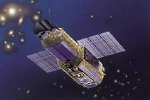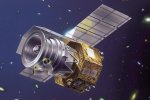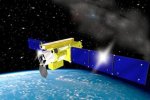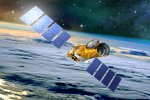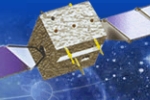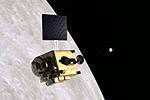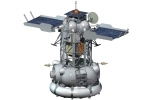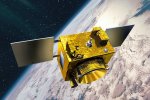ESA's Collaborative Missions
Suzaku |
||
Suzaku (previously called Astro-E2) was launched by the Japan Aerospace Exploration Agency (JAXA) and developed in collaboration with U.S. (NASA/GSFC and MIT) and Japanese institutes. Suzaku covers the energy range 0.3-600 keV and is currently performing astronomical observations using imaging CCD cameras (XIS) and a hard X-ray detector (HXD). Launched: 10 July 2005
News |
||
AKARI |
||
AKARI (formerly ASTRO-F), is the second space mission for infrared astronomy, from the Institute of Space and Astronautical Science (ISAS) of the Japanese Aerospace Exploration Agency (JAXA). Its main objective is to perform an all-sky survey with better sensitivity, spatial resolution and wider wavelength coverage than IRAS, mapping the entire sky in six infrared bands from 9 to 180 micron. Launched: 21 February 2006
News |
||
Hinode |
||
Hinode (formerly SOLAR-B) is the third solar physics satellite of ISAS and the successor of the Japan/US/UK YOHKOH (SOLAR-A) collaboration. SOLAR-B was successfully launched and placed in a polar, sun-synchronous orbit around the Earth by a M-V launch vehicle from the Uchinoura Space Center (USC). In this orbit the instruments are in continuous sunlight, with no day/night cycling for eight months each year. Launched: 22 September 2006
News |
||
CoRoT |
||
CoRoT (Convection, Rotation and planetary Transits) is the first space mission dedicated to exoplanetary research and designed for this purpose. The spacecraft is equipped with a 27 cm-diameter afocal telescope and a 4-CCD wide-field camera, is built around the PROTEUS spacecraft bus, and operates in a low-Earth orbit (LEO) of ~900 km (polar). Launched in December 2006 the mission has a nominal lifetime of 2.5 years (with possible extensions) during which time it will study stellar interiors and search for exoplanets. The project is led by CNES, with contributions from ESA, Austria, Belgium, Germany, Spain and Brazil. Launched: 27 December 2006
News |
||
Chang'e-1 |
||
Chang'e-1 is an un-manned lunar orbiting spacecraft and represents the initial phase of the Chinese Lunar Exploration Program. ESA is collaborating with the Chinese on this mission by providing spacecraft and ground operations support services to CNSA. The two agencies will also share data and encourage a visitors’ programme so that researchers can learn from each other.
Launched: 24 October 2007 |
||
Chandrayaan-1 |
||
Chandrayaan-1 is a mission of the Indian Space Research Organisation. In June 2005 an agreement was reached with ESA to provide a low X-ray spectrometer, a near infra-red spectrometer and a sub-keV atom reflecting analyser all to be built by institutes with the member states. Contact with the spacecraft was lost on 28 August 2009. Launched: 22 October 2008
News |
||
Phobos-Soil (Phobos-Grunt) |
||
Phobos-Soil (Russian name: Phobos-Grunt) was designed for a comprehensive study of the larger of the two Martian moons. The mission consisted of a spacecraft that would observe Phobos and its environment from orbit, a lander that would study it in situ, and a return module that would bring soil samples back to Earth. A Chinese orbiter, Yinghuo-1 (YH-1), piggybacked with the mission to be delivered in orbit around Mars. The spacecraft was launched on 8 November 2011, but the injection into an Earth-escape trajectory to Mars failed and contact with the spacecraft was lost. It eventually re-entered Earth's atmosphere and crashed into the Pacific ocean on 15 January 2012.
Launched: 8 November 2011 |
||
Microscope |
||
MICROSCOPE (MICRO-Satellite à traînée Compensée pour l'Observation du Principe d'Equivalence) is the third microsatellite of the CNES Myriade series. The main scientific objective is testing of the Equivalence Principle with a 100 times better accuracy than realised with experiments on Earth. Launched: 25 April 2016
News |

